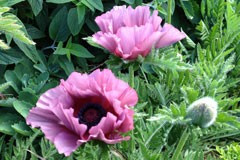- Out-of-Stock



A legendary oriental poppy with a distinct colour break from the usual pinks and reds, producing the most intriguing plum purple blooms. The dark flowers are subject to sun and wind burn so provide some shelter. If these are out of stock, we normally have more coming on in propagation.
A legendary oriental poppy with a distinct colour break from the usual pinks and reds, producing the most intriguing plum purple blooms. The dark flowers are subject to sun and wind burn so provide some shelter. If these are out of stock, we normally have more coming on in propagation.
Data sheet
Moisture fertile clay soil loving perennial, combining well with upright spikey varieties like veronicastrum, lysimachia etc.
An interesting variety which changes its foliage coloration throughout the season. Leaves begin as green then gradually turn golden in autumn with attractive red tints. Best in a dry rock garden or pot.
Attractive variety from Mexico with lavender and white flowers. A long flowering variety that attracts honey eates and butterflies, requires good drainage and a frost free environment to flourish.
Strong landscaping variety with bushy growth ideal for mass planting or hedges. Blue flowers in summer and drought tolerant once established.
Papaver Choir Boy produces beautiful white poppies with black central blotches, grow in fertile moisture retentive clay based soil and allow to dry out over late summer. Not for pots.
Spreading ground covering deciduous perennial for shade, with leaves like a small epimedium, soft yellow flower. Combine with dicentras, hellebores and pachyphragmas. Drought tolerant once established.
Native to Japan, a lower growing variety with attractive lobed leaves and pink bottlebrush flowers. In Australia part shade is best, on fertile clay or moisture retentive soil.
Silvery succulent, ideal in dry and exposed conditions including coastal situations. Flowers are coral pink during winter and the bushy form of this variety associates well with Stipa gigantea, aeoniums, fascicularia, and sedums.
Red form of Pulsatilla vulgaris, requires good drainage like other varieties, best for rock garden.
A useful border allium, flowering in mid summer, producing tall stems topped with spherical heads, about the size of crab apples. These begin green, then as the season progresses, burgundy colouration gradually extends down until the balls are entirely coloured. Best planted closely as a clump for good effect.
Deep cobalt-blue flowers on tall stems. Delphiniums love horse manure and require sheltered sunny conditions to do their best.
Spreading species from Korea with large white bells speckled pink. Attractive glossy foliage.
Resembles Euphorbia martinii in flowering, having a reddish brown spot within the green bract. Closer in habit to Euphorbia wulfennii, this a more dependable garden plant, proving itself as long lived in a variety of dry situations.
A graceful low mounding grass from Japan, best in shade and good soil. Useful for foliage effect amongst other woodland plants. This is the green foliage form, deciduous in winter.
A compact species for border and rock garden which works well for ground cover and edging, does not collapse like taller varieties. Very drought tolerant and tidy compact growth.
Native of Georgia and Turkey growing in shady places by streams in deciduous forest. A beautiful evergreen plant producing delicate porcelain blue flowers in the early spring. Works well as a mass planting beneath trees with hellebores and Geranium phaeum.

A legendary oriental poppy with a distinct colour break from the usual pinks and reds, producing the most intriguing plum purple blooms. The dark flowers are subject to sun and wind burn so provide some shelter. If these are out of stock, we normally have more coming on in propagation.